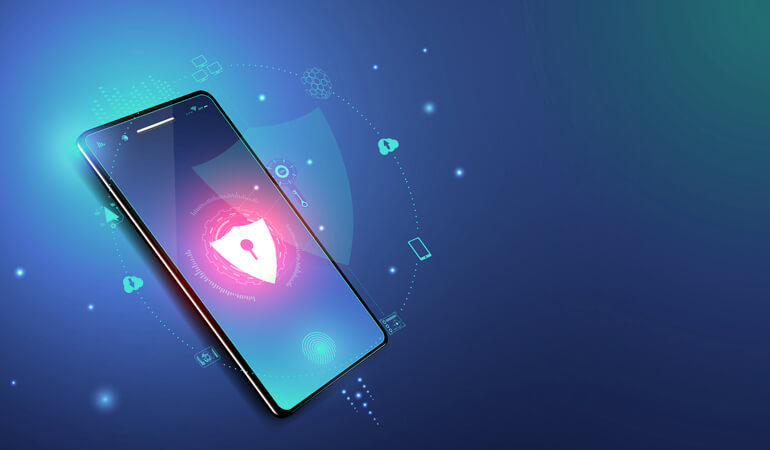
Whether your mobile phone is for personal or professional use, there is a heap of data that you want to protect and keep private There is also a financial risk when it comes to mobile apps as many mobile apps offer in-app purchases giving them access to your financial information. Since, many mobile applications are also collecting behavioral data in the background, which users are unaware of. This information helps businesses target ads towards the user and influence buying behavior. Therefore, for a healthy digital experience, developers must ensure mobile app security for their users. Can you recall what comes under the umbrella of mobile app security checklist.
The mainstream mobile software iOS and Android keep making significant progress to create and enable secure mobile phone experiences. There are many security options that app developers can implement straight away or give users control of their privacy settings.
Need for Mobile App Security Checklist
1. Browser-based attacks: These occur when hackers exploit vulnerabilities in outdated or insecure web browsers or through unsafe browsing activities. Also, by doing so, they can inject malware into the mobile device, compromising its security and potentially gaining access to sensitive information.
2. SMS-based attacks: In these attacks, hackers use deceptive tactics to trick individuals into downloading malware onto their mobile devices. This typically occurs by sending malicious links via text messages, luring recipients into clicking on them. Once clicked, the malware comes in the system, allowing attackers to exploit the device’s vulnerabilities.
3. Application logic-based attacks: Attackers exploit flaws in the logic of mobile applications to gain unauthorized access to sensitive data or infiltrate the device. This could involve bypassing authentication mechanisms or exploiting loopholes within the app’s logic. These attacks can lead to significant security breaches and compromise the integrity of the mobile app’s functionality.
This blog will share a mobile app security checklist of the most essential protection features of 2024. Let’s go over the mobile app security checklist.
Call and Message Encryption:
First on the mobile app security checklist is encryption. There are grave security threats to communications over the internet, such as calls, instant messages, or sharing audios, images, and videos. Users can become targets of snooping or man-in-the-middle attacks. High-ranking officials are often the subject of these attacks, so hackers can gain information to blackmail or steal authentication details.
Encrypting conversations helps users avoid leaks of any sensitive information. End-to-end encryption ensures that the data stored on messaging app servers and user devices is encrypted. The encryption key can be session-based, so it keeps changing, or 4096-bit SSL keys. Both options make decryption virtually impossible for hackers.
Frequent Security Patches for Apps and Operating Systems:
Another one on the mobile app security checklist is a security patch. Since the mainstream adoption of the internet, hackers have been a constant presence. Every new security measure taken and every new app designed presents new flaws that hackers exploit and try to damage the integrity of our devices. Also, last year ransomware viruses wreaked havoc across different platforms and devices, and older viruses such as trojan horse still continue to pester devices.
However, application developers must be open to reviewing the chinks in the armor they create and work diligently to protect users from such viruses. Therefore, users must also comply by frequently updating their devices’ operating systems and applications.
In hindsight, hackers encourage developers to continuously improve security measures and always be wary of cyberattacks. Let’s move other options on mobile app security checklist.
Regular Checks for Malware:
Next on the mobile app security checklist is a malware check. Malware can sneak onto your mobile devices quite easily, especially if you’re not internet savvy. Often malware comes in the form of download along with other internet files and remains dormant until you access any of these files or run an application.
There is a quick and reliable strategy to protect from malware that is already on the mobile device.
Built-in virus scanners are now provided on smartphones that can detect malware.
On Android devices, you can scan for malicious apps using the Google Playstore. Similarly, every time you restart the iPhone, iOS runs a malware scan. Developers must ensure that these scans are scheduled to automatically run to remove malware if they end up on the devices. Android security checklist is not complete without this one.
Protection from malware and other viruses is a top priority on the mobile app security checklist for best practices.
Multi-Factor Authentication Requirement:
Next on the mobile app security checklist is multi-factor verification. Smartphone users do not appreciate repetitive checks and authentication on their mobile devices. However, perhaps password protection is the most crucial mobile app security measure. It ensures that no one else uses a person’s device and can also be programmed to take counter-measures in case of theft.
Mobile app developers have made authentication much more convenient, so users do not feel troubled by authentication checks. A four-digit pin can be arranged into 10,000 possible combinations while being easy to remember for users.
The problem here is that many users opt for overly-simplified passcodes such as “1-2-3-4” or “0-0-0-0”.
In fact, around twelve percent of all users in a survey had one of these two security pins. For this reason, mobile app developers must encourage device owners to use slightly more complex pins that are tougher to crack. After all, there are 9,998 more combinations to try!
Android app security checklist also includes this. The latest range of even budget smartphones now contains biometric scanning devices. Moreover, biometric devices such as fingerprint scans or facial recognition are nearly impossible to crack or bypass. They are incredibly secure and require minimal effort. Developers must make a point of including biometric security wherever possible.
Another essential security option is multi-factor authentication. iOS app security checklist should have this option. This means you can add two or three steps to deploy multiple levels of security. Hence, multi-factor authentication can be a combination of pins, passwords, biometric verification, security questions, calls, and messages.
Protection Against Device Theft:
Another important thing on the mobile app security checklist is protection. Mobile app security does not end with the user. The chances of losing your device or having it stolen are pretty high. This requires mobile app developers to develop contingencies that can assist device owners in case of misplacement or theft.
GPS location tracking makes it possible to locate your device as long as you connect it to IoT mobile or wi-fi network. Google apps security checklist must have protection for theft too.
The best outcome of device theft is relocating it, as it gives the user access to their device, protecting them from monetary loss. It can also help locate the criminal who has stolen the device.
If the device cannot be recovered, developers can add contingencies. The safest contingency is a data wipe that erases all files from the device itself. The data wipe option is not ideal because vital data might be lost in the process. In this scenario, the best mobile app security measure is to allow cloud backup of the data user chooses. Therefore, by creating a backup, the user can recover their data, and the thief also cannot gain access to sensitive information on the device.
Data Leak Prevention:
Small bits of information can be stolen from the regular use of mobile devices. Even the savviest users might not catch on to how hackers can steal their data. Data-theft viruses like keyloggers and cloud hacks discreetly copy and reproduce data on the thieves’ devices. This is an important one on the mobile app security checklist.
This should be on your mobile device security checklist. The mobile app security best practices developers can adopt to prevent data leaks include blocking clipboard activities (copying and pasting) and screenshots. When accessing sensitive information like banking apps, disabling copy-paste and screenshot features protects that data from being leaked.
Mobile application security checklist also requires this. It is important not to miss anything on mobile security checklist. Developers can also warn users not to download sensitive files on their devices and access them instead on a secure server only.
Developers can also add watermarks to confidential documents that only authorized personnel should access. By adding time stamps and usernames, developers ensure that access to confidential documents can be tracked.
Conclusion:
Off all the to-do things on the mobile app security checklist which one do you think is most important? It is important to have a mobile app security checklist Ensuring mobile app security checklist is a continuous process. While mobile app developers have already introduced some innovative and safe measures, the threat of hackers and information thieves is always looming. A mobile app security check list will prevent your app from damages.
Privacy tools and authenticated applications help make the users’ digital experience secure. Additionally, developers should frequently schedule security updates for operating software and essential apps.
Users must also play their part in protecting themselves from cyber attacks and data theft by opting for verified applications, adding multiple security measures, and not giving access to their devices to other users.
To deploy the best mobile app security for creating enterprise apps, contact expert developers at Xavor. Our mobile app development team has decades of experience in fortifying data, creating secure backups, and integrating applications for safe and reliable collaboration. To benefit from Xavor’s mobile app development services and mobile app security checklist, contact us here.
FAQs
1. What is encryption, and why is it important for mobile apps?
Encryption secures data by converting it into a code that can only be accessed with the correct key, safeguarding it from unauthorized access or interception during transmission. It’s vital for protecting sensitive information like personal messages and financial data.
2. How often should I update my mobile apps and operating system for security?
Regular updates are crucial for staying protected against emerging threats and vulnerabilities. Aim to update your apps and operating system as soon as updates are available to ensure you have the latest security patches.
3. What is malware, and how can I protect my device from it?
Malware refers to malicious software designed to harm or infiltrate devices. Protect your device by using built-in virus scanners, avoiding suspicious downloads, and sticking to reputable app stores for software installations.
4. Why is multi-factor authentication important for mobile app security?
Multi-factor authentication adds an extra layer of security by requiring users to provide multiple forms of verification, such as passwords and biometric data. This helps prevent unauthorized access, even if one authentication method is compromised.
5. How can I protect my device from theft or loss?
Implement features like GPS tracking to locate lost devices and consider enabling remote data wiping capabilities to safeguard sensitive information. Additionally, back up your data regularly to prevent permanent loss in case of theft or loss.
6. What are data leaks, and how can I prevent them on my mobile device?
Data leaks occur when sensitive information is unintentionally exposed or accessed by unauthorized parties. Prevent them by disabling copy-paste and screenshot functions for sensitive apps, avoiding downloading sensitive files onto your device, and utilizing encryption for confidential documents.
7. Why is it important for developers to prioritize mobile app security?
Prioritizing mobile app security helps protect user data, maintain trust, and mitigate the risk of financial loss or reputational damage due to security breaches. By implementing robust security measures, developers can create a safer digital environment for users.
